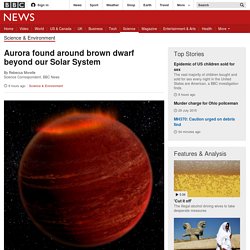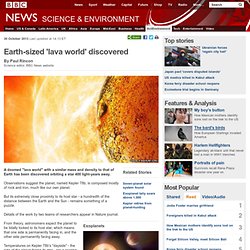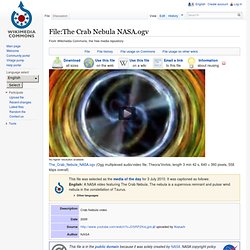

Aurora found around brown dwarf beyond our Solar System. An aurora has been spotted outside our Solar System for the first time, scientists report.

Complex organic molecule found in interstellar space. 26 September 2014Last updated at 05:56 ET By Michael Eyre Science reporter The scientists searched for the molecule deep in the Milky Way Scientists have found the beginnings of life-bearing chemistry at the centre of the galaxy.

Iso-propyl cyanide has been detected in a star-forming cloud 27,000 light-years from Earth. Its branched carbon structure is closer to the complex organic molecules of life than any previous finding from interstellar space. Supernova 'dust factory' pictured. 7 January 2014Last updated at 02:07 GMT By James Morgan Science reporter, BBC News, Washington DC.

Earth-sized 'lava world' discovered. 30 October 2013Last updated at 14:13 ET By Paul Rincon Science editor, BBC News website A doomed "lava world" with a similar mass and density to that of Earth has been discovered orbiting a star 400 light-years away.

Observations suggest the planet, named Kepler 78b, is composed mostly of rock and iron, much like our own planet. Silver in Space: Metal Found to Form in Distinct Star Explosions. It's long been known that earthly metals like gold and silver were forged in supernova explosions, but the metals' exact origins have been shrouded in mystery. Now a new study has identified the unique nuclear recipe for silver in space. (Related: "Huge Asteroids Brought Gold to Infant Earth, Study Says") While most common light elements like hydrogen and helium were formed in the big bang, heavier elements like carbon and oxygen are formed within stars through nuclear fusion. Rare heavy metals like silver and gold, however, need the most extreme stellar environments to form—found only during the explosions of massive stars, or supernovae.
(See supernovae pictures.) When these stellar titans die and explode, they spew new materials into space—the origin of most heavy metal elements on Earth, said lead study author Camilla Hansen, an astronomer at Heidelberg University in Germany. Exoplanet around Alpha Centauri is nearest-ever. 17 October 2012Last updated at 04:02 ET By Jason Palmer Science and technology reporter, BBC News Our nearest stellar neighbours have been the subject of study since ancient times Astronomers have found the nearest planet outside our Solar System, circling one of the stars of Alpha Centauri just four light-years away.

The planet has at minimum the same mass as Earth, but circles its star far closer than Mercury orbits our Sun. It is therefore outside the "habitable zone" denoting the possibility of life, as the researchers report in Nature. However, studies on exoplanets increasingly show that a star with one planet is likely to have several. The Crab Nebula NASA.ogv - Wikipedia, the free encyclopedia. Cancel Edit Delete Preview revert Text of the note (may include Wiki markup) Could not save your note (edit conflict or other problem).

Please copy the text in the edit box below and insert it manually by editing this page. Upon submitting the note will be published multi-licensed under the terms of the CC-BY-SA-3.0 license and of the GFDL, versions 1.2, 1.3, or any later version. See our terms of use for more details. Add a note Draw a rectangle onto the image above (press the left mouse button, then drag and release). Save To modify annotations, your browser needs to have the XMLHttpRequest object. [[MediaWiki talk:Gadget-ImageAnnotator.js|Adding image note]]$1 [[MediaWiki talk:Gadget-ImageAnnotator.js|Changing image note]]$1 [[MediaWiki talk:Gadget-ImageAnnotator.js|Removing image note]]$1. Eagle Nebula. A view of the stellar spire within M16, the Eagle Nebula.

The Eagle Nebula (catalogued as Messier 16 or M16, and as NGC 6611, and also known as the Star Queen Nebula) is a young open cluster of stars in the constellation Serpens, discovered by Jean-Philippe de Cheseaux in 1745-46. Its name derives from its shape that is thought to resemble an eagle. It contains several active star-forming gas and dust regions, including the famous "Pillars of Creation", photographed by the Hubble Space Telescope. Characteristics[edit] The Eagle Nebula is part of a diffuse emission nebula, or H II region, which is catalogued as IC 4703.
The brightest star in the nebula (HD 168076) has an apparent magnitude of +8.24, easily visible with good binoculars. The cluster associated with the nebula has approximately 460 stars, the brightest of spectral class O, a mass of roughly 80 solar masses, and a luminosity up to 1 million times that of the Sun. "Pillars of Creation" region[edit] Gallery[edit] See also[edit] Stargazing viewer in planet coup. 18 January 2012Last updated at 22:16 By Jonathan Amos Science correspondent, BBC News Amateur astronomer Chris Holmes form Peterborough stumbled upon SPH10066540 The public push initiated on BBC Two's Stargazing Live series to find planets beyond our Solar System has had an immediate result.

A viewer who answered the call has helped spot a world that appears to be circling a star dubbed SPH10066540. The planet is described as being similar in size to our Neptune and circles its parent every 90 days. Chris Holmes from Peterborough found it by looking through time-lapsed images of stars on Planethunters.org. The website hosts data gathered by Nasa's Kepler space telescope, and asks volunteers to sift the information for anything unusual that might have been missed in a computer search. "I've never had a telescope. "Being involved in a project like this and actually being the one to find something is a very exciting position. " This means the planet is probably too hot to support life.